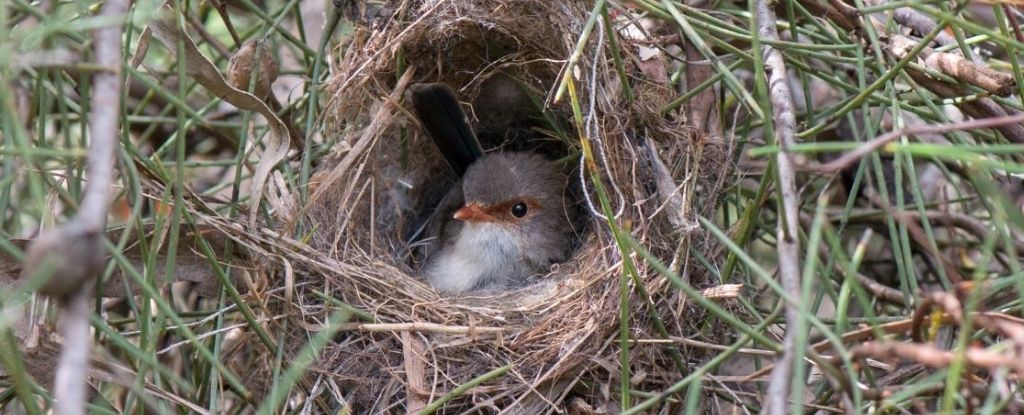A little over a decade ago, researchers in Australia were placing recorders in the nests of superb fairywrens (Malurus cyaneus) when they discovered something entirely unexpected.
The female songbirds were singing to their unhatched eggs.
Even more astonishing, when the chicks finally hatched, experts noticed that all the birds that grew up in the same nest used a similar tune to beg their mother and father for food.
The melody of trills and whistles they used was curiously reminiscent of a part of their mother’s song – the same one she sang to her offspring while they were still embryos.
To figure out if these offspring were learning their mother’s song from behind the shell, researchers shuffled the eggs between nests.
Sure enough, the chicks that later hatched sang the song of their new nest, not of their true one, indicating a learned behavior in ovo.
Now, a new study by some of the same researchers has found that this remarkable behavior extends to seven other, related species, including the splendid fairywren, the red-backed fairywren, the white-winged fairywren, the red-winged fairywren, the variegated fairywren, the purple-crowned fairywren, and the thick-billed grasswren.
In all of these birds, researchers recorded females singing to their unhatched eggs, usually starting around day 10 of incubation. No other nearby birds were visible in sight.
The findings suggest the behavior is ubiquitous among Australian wrens, a family known as Maluridae, and may, in fact, have evolved in their common ancestor millions of years ago.
Virtually all birds are known to make instinctual noises to communicate, but birdsong is a learned trait that many scientists, like Charles Darwin, assumed had evolved almost exclusively among male birds for courtship reasons.
By comparison, female birdsong was historically considered exceptional and pointless – until, that is, a recent study found over 70 percent of female songbirds worldwide also sing. Australia, home of the fairywrens, is actually where birdsong first evolved roughly 33 million years ago.
The new discovery among female fairywrens of a variety of species adds weight to the idea that female song is not an evolutionary mistake, but can serve a very real and very important purpose in avian life.
But while egg exposure to bird calls has been linked to imprinting and sensory development, the way that birdsong is learned in the embryo stage has gone largely unexplored. Plus, the research that does exist often uses birds that are socially isolated.
“In this study, we show maternal behavior that is concordant with pupil-directed vocalization behavior when mothers call to their embryos,” says animal ecologist and senior author Diane Colombelli-Négrel from Flinders University.
Across all eight species considered in the Australian wren family, researchers found the offspring repeated back a part of their mother’s call, known as the B element.
After hatching, the chicks sang this song to beg for food from their parents. The accuracy of their attempt was improved if their mother had sung the song at a slower rate to them when they were just embryos, which indicates the embryos really were paying attention to the songs.
Of all the parts of a fairywren’s song, females sang the B element to their eggs most, up 96 percent of the time.
Other elements, like A, might have been sung as well to provide a contrast for the embryos, possibly allowing them to tease apart various tunes when they finally hatch.
As expected, when researchers played female songs back to superb fairywren embryos, the unhatched offspring showed a stronger heart rate response to element B than any other part.
Colombelli-Négrel and her colleagues don’t know why this early learning of song might have evolved, but they have a few ideas.
Vocalizations in the nest may help fairywrens avoid being fooled by cuckoos, which lay their eggs in other birds’ nests to avoid the demands of raising their own young.
Cuckoo eggs only incubate for a few days, which isn’t long enough to learn the begging song of Australian wrens. When the eggs hatch, it’s unlikely the wren mother will feed the intruder as they don’t have the right ‘password’, researchers say.
Another possibility has to do with sexual selection.
Far from being passive players in courtship, which involve males singing songs to females, it could be that by singing to their own young, female wrens are teaching their offspring to favor certain cultural traits, which will then be carried on to the next generation.
The more that scientists recognize the incredible songs of female birds, the more they are beginning to realize: females are hardly the weaker or more silent sex.
The study was published in The American Naturalist.





